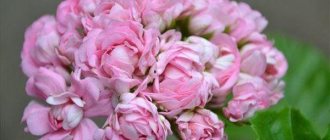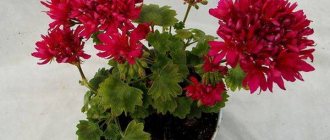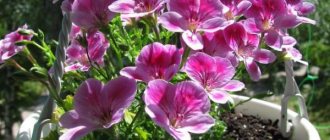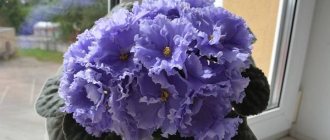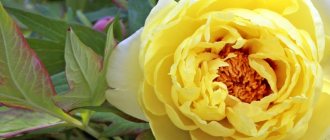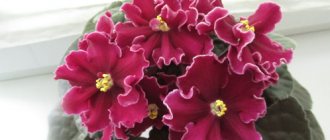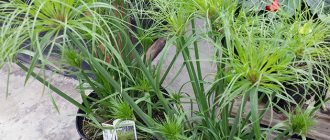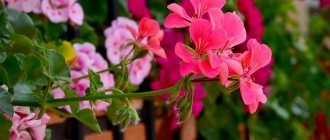Botanical description and history
Pelargonium terry is an indoor (sometimes garden) plant that belongs to the Geraniaceae family. In the natural environment they are found in the form of subshrubs, and a little less often - shrubs. There are both annual and perennial varieties. Among these varieties there are also terry varieties, which in turn are also divided into subspecies:
- royal;
- zonal;
- ivy-shaped (ampeloid) and so on.
The variety received its name due to the special arrangement of petals - in one row there can be up to eight petals at the same time.
They all grow not side by side, but as if investing in each other. Due to this, the bud looks very lush. The birthplace of the described flower is considered to be South Africa, as well as India. The plant first appeared in European countries at the end of the 18th century. Residents of Europe immediately appreciated the plant and began planting them en masse in their flower beds and window sills. Over time, pelargonium was named a symbol of the Victorian era and became an attribute of comfort in every home.
Description of appearance and features
Terry pelargoniums are distinguished by a large number of petals, which are collected into buds similar to umbrellas. The outer side of the petal is always slightly lighter than the inner. Due to this, additional volume is added to the entire flower.
The shoot of the flower grows straight, it is quite strong and does not require additional support. The leaf blades feel a little velvety to the touch. The buds can be found in a variety of colors - from pure white to deep purple.
The peculiarity of the plant is its tart aroma, which is not suitable for everyone, and some, on the contrary, consider this feature an advantage.
The best indoor varieties
There are about 500 varieties of geraniums, differing in the shade of the petals and the size of the bush:
- Pelargonium pebbles. This is a compact, neat bush that does not require shaping. Compared to the small size of the plant itself, the double pink-crimson flowers look even larger.
- Pelargonium Mimi. Terry dwarf pelargonium Mimi is recognizable by the soft pink hue of its inflorescences. The bushes grow very slowly.
- Mallorca pelargonium. The unusual shape of the flowers of the Mallorca pelargonium (you can find such names as Mallorca pelargonium, Majorca, majorca) explains the classification of this variety as a cactus. The main feature of the plant is its jagged petals with red, white and greenish stripes.
- Pelargonium Saxdalens Selma. Selma is a pelargonium with strong, low shoots and soft pink inflorescences. It will decorate any flower bed or room.
- Silk Moira. This is a spectacular variety of terry pelargonium. The miniature bush is decorated with dense light apricot inflorescences.
- Brooks >
The underside of the petals is almost white, so it gives the impression of two colors
Other varieties
The list can be supplemented with the following varieties:
| Name | Inflorescences |
| le Pirate | Reds |
| PAC Viva Maria | White with a crimson spot at the base of the petals |
| Lake | Pink, becoming almost white towards the edges |
| Plenum | Changes from blue to lavender |
| Elmsett | Cream with red dots |
White terry geranium (Delta Pearl, Artic Princess, Joan of Arc, PAC Blanche Roche) is especially popular among gardeners.
Description and photos of varieties
Purple
This variety includes many more subspecies . For example:
- Brookside Fantasy (light violet-lilac color, rather lush, terry brushes);
- Amethyst (lilac color);
- Lara Gem (lilac shade);
- Bold Pixie (colors vary from lilac to purple);
- PAC Icecrystal (violet-lilac).
White
This type, in turn, is also divided into groups:
- Granny Barter (in appearance they are somewhat reminiscent of the students’ snow-white bows);
- Artic Princess (pure white buds, similar to a ball);
- Delta Pearl;
- PAC Blanca;
- Dowepoint;
- Destiny.
Angel
This variety deserves special attention. In appearance it resembles royal pelargonium. The only difference is in the shape of the bush - in Angel it curls, and does not grow as a lush bush.
Another distinctive feature is the small size of the flowers - usually their diameter does not exceed two centimeters. The height of the bush reaches 35 centimeters. If it goes higher, it should be cut off, otherwise all the decorativeness will disappear. The shade of the petal can be different - from soft pink to lilac. In some cases, there are species with spots and stripes on the inside of the petal.
Description of the plant
In total, botanists know about 250 species of pelargonium. They occur in the form of a herbaceous plant, subshrub and small vine. Depending on the group, pelargonium can reach 50 centimeters in height, like the zonal ones, or stretch up to a meter, like the ivy-leaved pelargoniums. The shape of the leaf plate is also very diverse. Rosebud pelargoniums in the zonal group are characterized by green leaves with a dark border, covered with fine down. The edges of the leaf plate are wavy, smoothly rounded. In the group of ampelous pelargoniums, the leaves will be thick and fleshy, with a glossy surface, almost without hairs. There are varieties with variegated foliage.
But the plant acquired a special love among gardeners and its name thanks to its buds. They consist of many petals, when opening, they take on a shape similar to a rose, but unlike it, the buds are collected in an umbrella inflorescence, rising on a long peduncle. Moreover, the plant is not so demanding to care for. Pelargonium petals are painted in a variety of colors, when fully blooming, the inflorescence takes the shape of a ball. After flowering, a capsule fruit is formed. The sepals are retained on it, and the opening occurs from the tip of the capsule to the base.
Beneficial features
Rosemary and geranium oils are used as a stimulator of love energy. The oils are mixed in equal quantities, but do not shake. Can be applied to the skin as perfume or used in an aroma lamp.
All parts of pelargonium are used as medicinal raw materials. Essential oil has a wide range of uses.
It promotes:
- increasing mental activity and physical activity;
- restoration of the skin after thermal burns and frostbite;
- healing in the treatment of neuritis and hormonal problems in women;
- victory over infertility;
- normalize high blood pressure.
The oil is used to prevent viral diseases and relieve inflammatory processes and obsessive depression. Often used in cosmetology for problematic and oily skin, as the oil has a soothing, moisturizing, and mild anti-aging effect. It can smooth out small facial wrinkles.
You can use the oil on its own (mixed with a base oil) or in combination with other oils, as well as enrich creams and shampoos with it.
Cosmetologists treat diseases such as:
- psoriasis;
- eczema;
- skin fungus;
- herpes.
How to plant correctly?
Choosing a location and lighting
This pelargonium requires a lot of light. With its deficiency, the foliage begins to turn yellow and, over time, completely fall off. Therefore, the most suitable place for a flower is the southern and eastern sides of the room. In winter, you will have to resort to additional lighting.
Important! Make sure that artificial lighting lamps do not leave burns on the surface of terry pelargonium.
Soil requirements
To grow a healthy and profusely flowering plant, you must adhere to the following rules when preparing the soil:
- The substrate must be fertile and loose.
- You can use universal soil purchased at the store, but add peat and coarse river sand.
- Before planting, add mineral fertilizers to the substrate.
- Be sure to put a drainage layer, which can be made from expanded clay pebbles.
- Soil acidity should be at a neutral level.
Home care rules
Watering
In summer, the soil is moistened 3-4 times a week. It is better to do this with settled water at room temperature.
It is important to ensure that water does not accumulate in the soil. The most optimal method of watering is through a tray. This way the plant will take the required amount of water, and you will drain the excess. In winter, the frequency of watering is reduced to once a week.
Air temperature
Pelargonium feels best in average climates. Therefore, you need to provide it with a temperature within 20-25 degrees. If the indicators increase, it is worth cooling the plant a little. To do this, you can spray the air around.
Humidity
This indicator should always be at the level of 65-70%, try not to raise it higher. But if the room is very stuffy, you can slightly raise the humidity , but you do not need to spray the plant itself.
Trimming
Terry pelargonium is a plant that requires constant pruning in order for the bush to form the correct shape. As soon as the florist sees that the shoots have become too long and the flower loses its decorative effect.
This procedure is carried out with a well-sharpened instrument so as not to injure parts of the pelargonium. After pruning, exposed areas can be treated with insecticides to protect the plant from infection.
Top dressing
Fertilize the plant twice a month. For this they use ready-made mineral complexes, which can be purchased at any flower shop. However, make sure that the fertilizer contains the following in equal proportions:
- potassium;
- magnesium;
- phosphorus.
In winter, the subcortex is completely stopped , allowing the plant to rest and recover.
Reference! It is necessary to regularly ventilate the room so that the air does not stagnate in it and various parasites do not appear. But make sure that a harmful draft does not form.
Features of caring for rosebud pelargonium (video)
general characteristics
This plant is perfect for garden plots, but it is also actively bred at home. Belongs to the group of zonal (Simonelli) pelargoniums. It is quite demanding in care, but under favorable conditions it will delight the eye every year with its beautiful lush inflorescence.
In winter, special conditions must be created for the plant so that it “hibernates.” Maintain a constant temperature of 12-14 degrees Celsius, choose a dark place. This way the geranium will not waste its energy and will calmly survive the winter months.
Features and timing of flowering
The crop blooms only in the summer months, which is when it looks especially luxurious. The rest of the time, geranium does not look impressive.
The big plus is that the flowers do not fall off individually. Each bud begins to dry out; the housewife only needs to remove it in time so as not to disturb the attractive appearance of the plant.
Popular varieties of pelargonium rosebud
- Albina - white leaves may look banal, but the greenish tint is the main decoration of this variety;
- Beverly Park - suitable for those who prefer a non-standard red color scheme;
- Denise is an unusual and beautiful variety with peach petals and pink edging;
- Natalie - has an unusual salmon tone;
- Appleblossom rosebud is a white bud with a greenish center and a lilac-lilac edging.
Diseases and pests
Often, only errors in care lead to problems with terry Pelargonium. It can be attacked by the following parasites:
- Root rot. The reason for the development is excess moisture in the flowerpot. This disease cannot be cured. Therefore, the affected plant is immediately destroyed so that other flowers do not become infected.
- Gray mold. Appears on leaf plates. The way to fight is as follows:
- Watering stops.
Affected foliage is removed.
- Treatment with an antifungal agent is carried out.
- Blackleg. It primarily affects only shoots. It develops due to excess moisture in the flowerpot or from other affected plants. In this situation, there is only one way out - to get rid of the soil and the plant itself. However, in order to preserve terry Pelargonium, you can cut healthy cuttings from it and root it. Prevention of infection is disinfection of the soil.
- Lengthening the stems, which also remain without leaves. This process indicates a lack of lighting.
After this, the pelargonium is placed in a well-lit place.
What does terry pelargonium look like, what features does it have?
This flower has many petals forming an umbrella-shaped inflorescence, similar to a round cap. The petals are lighter at the bottom, which gives them fluffiness.
The flower is placed on a concentrated straight stem with lush leaves. If you touch them, you can feel some velvetyness. Inflorescences have any floral colors.
What does pelargonium look like?
Pelargonium is not bad for everyone: some may get a headache due to the tart smell of the foliage. Because of it, insects like flies and moths avoid being near the flower. But the smell of the plant has a beneficial effect on some people:
- calms;
- treats migraine;
- helps to fall asleep with insomnia;
- improves the quality of life for hypertensive patients and people suffering from pathologies of the heart and blood vessels.
This plant has some medicinal effects.
Fascinatingly!
Caring for the plant is not too difficult; it loves light and can survive drought.
Features of reproduction
To do this, you can use two methods - sowing seeds and cuttings.
By cuttings
- It is best to cut off the shoot in the spring. It is necessary to select a cutting 5-7 centimeters long from the lateral or apical shoots. Do not forget that pruning is carried out only with a well-sharpened tool.
- After this, you need to get rid of the lower leaves on the shoot, leaving only the top two or three.
The finished shoot is dried in the open air for several hours.- It wouldn’t hurt to treat the cut areas with an insecticide or just wood ash.
- The container for planting is chosen to be very small. A regular plastic cup will do. You need to make several holes at the bottom for air circulation or excess liquid to drain.
- Before planting, the soil is disinfected. To do this, it is treated with a weak solution of potassium permanganate.
- After drying, the cuttings are placed in a container.
- The flower pot is placed in a well-lit place, but so that the sun's rays do not fall on it.
- Water the cuttings as needed - only after the soil has dried.
- The air temperature should not fall below 15 degrees Celsius.
Often, after three to four weeks, the cuttings take root.
Seeds
If the gardener decides to propagate terry pelargonium using seeds, he should adhere to some rules.
- The time for sowing seeds is from the beginning of autumn to the end of spring. It is advisable to use purchased materials for this.
- The usual universal soil will do, but you will need to add a little peat to it.
- If you collect seeds from flowering plants yourself, it is better to wipe them with sandpaper for better germination.
- The seeds are planted shallow in the ground. A space of five centimeters is left between the planting material. After this, the soil is moistened with a spray bottle.
- The container with seeds is covered with film or glass.
- The temperature should be maintained at 20 degrees.
- Within a week you will be able to see the first shoots.
- The seedlings are planted in separate containers only after three or four leaves appear on them.
Pelargonium is one of the few plants that captivates not only with its appearance, but also with its pleasant aroma. Delicate buds, distinguished by a variety of shades, make this flower one of the most popular among flower growers in many countries of the world. We recommend reading our materials on growing species such as: Bold, Patricia Andrea, Rococo, Stellar, Silk, Pak Viva, April Snow, Red Pandora, Edwards Elegance and Tuscany, Ludwigsburg Flyer.
Terry pelargonium is one of the most beautiful representatives of its family. Which also does not require special care. You just have to follow a few simple rules, and the flower will thank you with its excellent appearance.
